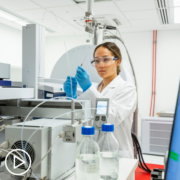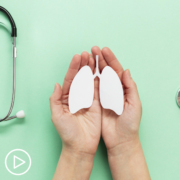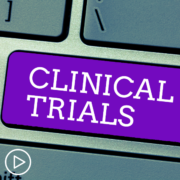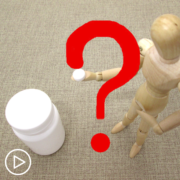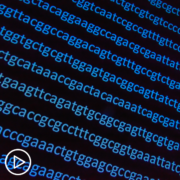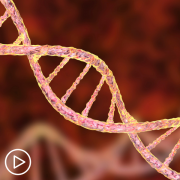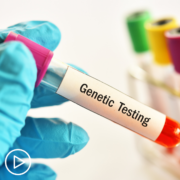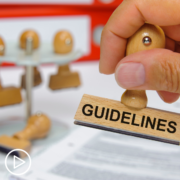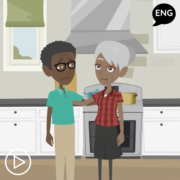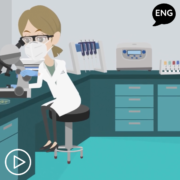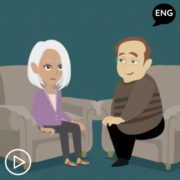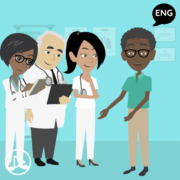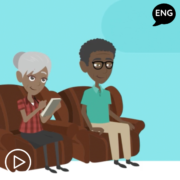HCP Roundtable: Improving Clinician-Patient Conversations in Lung Cancer Biomarker Testing from Patient Empowerment Network on Vimeo.
Comprehensive biomarker testing can play a very important role in the personalized treatment for patients with non-small cell lung cancer (NSCLC). How do we improve clinician-patient conversations in biomarker testing? And how do we remove barriers that can impede an HCP’s ability to treat patients with personalized care?
Dr. Heather Wakelee, Professor of Medicine and Chief of the Division of Oncology at Stanford University School of Medicine and Dr. Leigh Boehmer, medical director at Association of Community Cancer Centers (ACCC) weigh in on this very important topic.
Download Resource Guide
See More from Lung Cancer | Empowering Providers to Empower Patients
Related Resources:
Transcript:
Dr. Nicole Rochester:
Welcome to this Empowering Providers to Empower Patients (EPEP) program. I’m Dr. Nicole Rochester, pediatrician and CEO of Your GPS Doc. In this Patient Empowerment Network program, we connect leading lung cancer expert voices to discuss enhancing physician-patient communication and shared decision-making in lung cancer care. Some of the topics we’re going to tackle in today’s conversation include the challenges and solutions for biomarker testing in the community hospital setting and in academic centers.
We’re also going to talk about removing barriers that can impede a healthcare provider’s ability to treat patients with personalized care, improving clinician-patient communication with regard to NSCLC biomarker testing, and we’re also going to explore opportunities to improve access to personalized care for all patients. I am thrilled to be joined by thoracic medical oncologist, Dr. Heather Wakelee, Professor of Medicine and Chief of the Division of Oncology at Stanford University School of Medicine. Dr. Wakelee is also President of the International Association for the Study of Lung Cancer. I am also thrilled to be joined by Dr. Leigh Boehmer, Chief Medical Officer at the Association of Community Cancer Centers. Thank you both for joining us today.
Dr. Leigh Boehmer:
Thank you.
Dr. Heather Wakelee:
Thank you.
Dr. Nicole Rochester:
So we know that biomarker testing connects the right patient to the right treatment at the right time and potentially to the right clinical trial, but there also are some challenges and interventions are necessary, and that’s going to really frame our conversation today. So I’d like to start with the general landscape, so I’m going to start with you, Dr. Wakelee, what in your opinion and expertise are the existing challenges as it relates to biomarker testing in academic medical centers?
Dr. Heather Wakelee:
Thanks for that question, Dr. Rochester. I think that the biggest challenge is making sure that every patient with a new diagnosis of advanced stage non-small cell lung cancer gets the testing done and gets the testing results back before they start treatment, right? And that’s the goal. I guess that’s more of the goal than the problem, and the challenges come in each of those different phases. First is making sure that every patient is given access to the testing, and there are barriers if the patient ends up very, very sick in a hospital setting.
There are some regulations that can make that challenging, they might be…their first encounters with the healthcare system are going to potentially be with pulmonologists, general practitioners, interventional radiology. And those people might not be aware of what needs to happen to get the tissue as quickly as possible into testing, they might not be as aware of drawing a blood test, if we’re going to do a liquid biopsy, and so if those things aren’t initiated first, when the patient gets to see the oncologist some days or even a week or two later, we’re already further down the path.
They might be starting to get symptoms, and then when you start the testing, you might have to wait longer than is really acceptable before you have the results that could inform treatment. And as you said, Dr. Rochester, the testing, when we get those molecular results back, that’s going to help us figure out what’s going on in that tumor that might change our treatment options, because there’s a driver mutation where there’s a new drug approved that’s going to be the best efficacious opportunity for that patient. And if they don’t know, they can’t start it, we also run into issues where if the patient’s symptomatic, we can’t wait, and then they get started on chemotherapy and immunotherapy, which might otherwise be a standard approach, immunotherapy is in the body, chemotherapy is in the body, the toxicity is there, and then if you later find out, oh, there was a driver mutation, your hands are a little tied, because the toxicity can be amplified if you combine agents and the immune therapy is in the system for months.
So these are some of the challenges and really the barriers…the biggest barriers from my perspective are not every patient is being tested with comprehensive testing as early as possible, right?
Dr. Nicole Rochester:
Thank you for that, Dr. Wakelee, you’ve really, really outlined how the challenges around access to testing and even the timeliness and the importance of timely testing and the fact that these patients are often kind of making their way through a series of providers before they get to the oncologist. So I appreciate that. Dr. Boehmer, I know you have a lot of experience in the community setting where we know there are a host of additional barriers, so I’d love for you to weigh in on this question, and what challenges are you seeing with biomarker testing in the community setting?
Dr. Leigh Boehmer:
Thanks very much for the question. Yeah, I think the use of precision medicine was initially touted as this opportunity to address care disparities, whether that’s in racial ethnic minorities, differences between academic and community practices, et cetera, by using the technology to try to determine treatment largely based on things like the genetic makeup of a tumor. And, unfortunately, in reality disparities have sadly only continued to grow in the setting of targeted and/or testing related to things like ability to pay and insurance coverage for testing, mistrust in the healthcare system, and historical injustices related to cancer care delivery. And there’s a significant discordance in literature between patients and clinicians understanding of the importance of biomarker testing relative to treatment planning.
So even now in 2023, as more states are passing legislation to expand coverage of comprehensive testing, we’re hearing from member programs of ACCC running up against increasing prior authorization restrictions and requirements, and there are unfortunate ramifications of that, like additional costs to programs or additional costs to patients, for example, in the setting of reflexive testing, there’s also a lot of ongoing data which suggests concerning continued racial disparities in rates of guideline concordant testing. So there’s a lot of opportunities for us to learn, yes, from what we have done in successful models of rollout of testing, but we’re still confronting some pretty major challenges and barriers, and I’ve got to say that’s true whether you’re talking about community programs and practices or academic partners as well.
Dr. Nicole Rochester:
I really appreciate you adding that layer, Dr. Boehmer. As someone who does a lot of work in health equity, I was just sharing prior to us recording that these disparities are pervasive, and now we’re learning it’s in lung cancer, and for all of the reasons that you stated, and it’s interesting that when we really start to look at our progress, and when we look at it by comparing different racial and ethnic groups, we find, as you stated, that sometimes the disparities actually widen.
And so it’s not that these aren’t great practices and precision medicine is a wonderful thing, but to your point, if we’re not ensuring that everyone has access to this new technology, then in fact, not only do we continue to see disparities, but sometimes that we inadvertently worsen them. So I appreciate you sharing that. Both of you have been on the ground floor of research in this area with regard to biomarker testing and availability and disparities. So I’d love for you to talk a little bit about the data and what does the data tell us with regard to biomarker testing? It’s important, some of the challenges that you both just stated, and so I’ll start with you this time, Dr. Boehmer.
Dr. Leigh Boehmer:
[chuckle] Thanks, I appreciate it. I’ve been privileged to work with both providers and patients’ caregivers, taking a closer look at some of the barriers and then practical solutions that might be utilized to address some of these concerns around testing. So back in 2021, ACCC used the mixed methods approach to try to understand the motivators of patients and providers, their practice patterns, their attitudes, the educational needs of patients and providers related to biomarker testing and beyond. And you know what’s really interesting, in almost 100 total provider respondents, less than half of community clinicians who responded said that they used biomarker testing to guide patient discussions.
And that was compared to nearly three-quarters of all responding academic clinicians, and it really made us start to think about…so, you know, the impetus for testing in the context of testing. In this particular research, to my earlier comments, we were actually targeting patients with non-small cell lung cancer who were uninsured, underinsured and/or covered by Medicaid. So dual eligible beneficiaries, and it was really interesting because we looked at why and how conversations were happening about biomarker testing between providers and patients, and really identified some tremendous opportunities for education around clinicians’ needs to become more familiar with guideline concordant testing and to have more practical applications of guideline concordant testing, so things like case-based examples, so then ultimately they could have optimal conversations with patients and help coordinate multidisciplinary care.
There’s also data which would suggest a disconnect between ordering testing after initial staging versus ordering testing at the time of initial biopsy. And, Dr. Wakelee, you said something that really resonated with me because if we can identify patients who need to be tested, if we can have access to testing, we still have a disconnect, and this is largely seen in community programs today where clinicians may be waiting 10 days, 14 days, even longer to receive results of testing. And you’re right, we have patients who need treatment initiated sooner than later, and you miss these opportunities because of delays, prior authorizations and a lot of other things, So the data certainly quantitatively, qualitatively is speaking to this hierarchy of problems and there’s definitely some mismatches between patient and provider perceptions of why testing happens, what it’s used for, and timing of the testing and results sharing.
Dr. Nicole Rochester:
That is fascinating, and we’re definitely going to get deeper into that, this whole patient-provider interaction, so I really appreciate you introducing that and thank you for all the research that your organization has done in this area. So, Dr. Wakelee, you’re on the academic side of things, and you also have been deeply involved in research in this area, so what would you like to offer from your perspective in terms of the data around biomarker testing?
Dr. Heather Wakelee:
Well, thanks, and, Dr. Boehmer, you have a very comprehensive answer there, I think that the differences between academic and community sometimes are broad and sometimes aren’t that big at all, and I do think we face a lot of the same challenges. It’s just…it’s making sure that when a physician is meeting with a patient, and let’s say it’s with the oncologist, that the oncologist is really mindful that any patient with non-small cell lung cancer could have a tumor with a driver mutation. I think it’s easy to stereotype and think that only certain patients are going to, and therefore we shouldn’t be testing everybody. And that gets dangerous. I think it also is a matter of where you’re in practice, and if you’re in a practice where the prevalence of the driver mutations and the tumors is low, you might just say, “Oh, I’m never going to see it,” and you stop testing, and that’s also very dangerous because we have seen in multiple trials, as we get back to that research question, that if we can identify a driver mutation…
And we know that more than half of patients who’ve developed lung cancer who have never smoked or have a light smoking history are going to have an actionable driving mutation, and even in people who do have a smoking history, of any ethnic background, they’re still 10 to 20 percent or maybe more as we identify more of these driver mutations, where that’s what’s really the force in the tumor. And if you find it and you can start someone on the appropriate targeted therapy, usually across multiple trials, the toxicity is less than you would get with chemotherapy or immunotherapy.
Usually the probability of response is over half, you know, if someone’s going to have a benefit that that’s going to help them feel better for a period of time in controlling their cancer, it really drastically changes their whole tumor outcome, they’re going to be living longer, feeling better, and ultimately that’s our goal when we’re helping someone with metastatic disease. And if you don’t know that the tumor has a driver mutation, you’re never going to give them that appropriate treatment, and I think that is the real challenge that we face, and there are multiple different angles to that, right? You have to have the physician aware of the importance of finding the mutation, altering the treatment as necessary, and giving that patient the best possible option for care.
But it also is making sure that the patients are open about this, because I think there’s still a lot of misperceptions about when we talk about driver mutations and the word mutation, making sure that people understand we’re talking about the cancer and not about the person. And in a short conversation that can sometimes be missed, and then people are afraid of getting tested, afraid of what that might mean for them or their family, and so the communication around, we’re going to test your tumor because your tumor might have a mutation that’s going to allow us to give different care. I think that’s really important that people always remember to talk about the tumor and not about the mutation in the person, that’s really, really critical.
And also to avoid that stereotyping about who do we test and who do we not test, pretty much anyone with a non-squamous, non-small cell lung cancer, their tumor needs to be tested, and many people who have a squamous cytology that’s also reasonable. So that’s the people aspect of it, the insurance barriers and the interpretation of the results, those are still there as well. And even if you have perfect communication and the patient understands and you get the testing done immediately, you still have to deal with, is it going to get covered or not? And the results come back, is it going to be interpretable or not? Because that can sometimes be tricky also.
Dr. Nicole Rochester:
Wow. I would say you two have really uncovered a lot of barriers, and it’s enough to make someone feel a little bit discouraged, I would say, however, because of the work that both of you are doing and so many others, we know that there indeed is hope. And so I’d love to shift a little bit. We’ve talked a lot about the barriers, which are many, what’s on the horizon or what positive trends have you all seen, and specifically what are the opportunities, what are some things that are either happening or that are being explored with regard to removing some of these barriers or all of the barriers that each of you have talked about? I’ll start with you, Dr. Wakelee, give us some hope.
Dr. Heather Wakelee:
All right. Great. Well, I think there is reason to have hope. Absolutely. There always is reason to have hope. And so many organizations, including ISLC, including ACCC, including NCC…I mean, you could name any organization that’s involved in cancer care and education, is really focusing on this issue of making sure that every oncologist knows the importance of doing biomarker testing for patients with non-small cell lung cancer, that we are trying to expand that not just to the oncologist, but also to the folks making the diagnosis, so they can be aware as well. Patient advocacy groups are very engaged in this as well, making sure that when someone is newly diagnosed, if they reach out to an advocacy group, one of the messages they hear is, have you asked about testing what’s happening with the tumor testing?
The more people who are aware that’s a standard of care in treating lung cancer, the more that’s going to happen, and then continuing to explore those financial barriers, and as more agents are FDA-approved, where that becomes a preferred first sign option, but you only know that if the testing’s happened, that leads to campaigning to make sure that the testing is being covered as well, you know, when you can argue, this patient isn’t getting the FDA-approved best care for their cancer because that testing wasn’t done, that’s a really powerful statement. And I think that’s what we’re seeing change happening.
Dr. Nicole Rochester:
That is incredible, thank you. Thank you so much. I can smile again.
[laughter]
Dr. Nicole Rochester:
What about you, Dr. Boehmer? I know you’re getting…your organization is doing a lot of work in this area, so tell us about some of the advances, some of the improvements and tackling some of these barriers that both of you have elucidated today.
Dr. Leigh Boehmer:
So, Dr. Wakelee, thank you for all of those hope-inducing concepts and methodologies, because I honestly believe that so many of us learn best today by seeing someone like me doing X, Y, Z, so I know I can do it as well. So I think it’s about documentation of justification of testing for prior authorization claims. I think it’s about working together with the multidisciplinary team, pharmacist, advanced practitioners, oncology-certified nurses to help manage that back and forth with testing and external pathology and laboratory companies, to make sure that results show up in the right spot in the electronic health record so that they can be interpreted, shared with patients, communicated and contextualized in real time. I think it’s about greater incorporation as we’ve seen across so many of our programs of the tenets of shared clinical decision-making, and how to have a meaningful conversation with a patient and/or their caregivers about testing and its role on treatment and drug selection, and outcomes, and progression-free survival. And there are a lot of programs out there that are doing bits of this or different points along that continuum.
ACCC, for example, building on the research I shared before, recognizes that a lot of community programs don’t have kind of operational best practices for how to incorporate biomarker testing into a patient’s journey, and so for lung, and also, for example, for breast cancer, we’re working on creating care pathways which will help multidisciplinary clinician teams integrate discussions of biomarker testing and its impact at various critical time points along a patient’s diagnosis to treatment, to survivorship or end-of-life care. And those are just examples of us not being overly duplicative, but putting all the resources in one place, talking about timing, talking about when and how to have meaningful conversations, and then doing it with health-literate, vetted resources and through a lens of equity and shared decision-making, because you look like me, you had success with it. I’m going to do it for my at-risk patients as well, because one, it’s the right thing to do. And two, you taught me how to do it, and three, you told me what success looks like so I can measure myself against you, and that’s a successful model for scalability.
Dr. Nicole Rochester:
That is wonderful. You both have nicely taken us into the next part of the conversation, and, Dr. Boehmer, you just talked about shared decision-making, and as someone who works very closely with patient advocates and health advocates, it’s so important that any effort to improve care with regard to any disease or illness, it has to involve the patient and their family, so I really appreciate you all sharing that. So, with that in mind, and as we begin to think about how the patient-provider relationship and the patient-provider communication plays a role in addressing some of these barriers that we’ve been talking about and then making sure that patients are appropriately being tested and treated, I’d love to hear from you all regarding the role of the patient-provider partnership as it relates to biomarker testing. So, let’s see, I’ll start with you, Dr. Boehmer.
Dr. Leigh Boehmer:
So I really, really think this question is critical, and I’m going to bias by saying, an exciting new position on the multidisciplinary cancer care team that we are learning about it, some of our member programs, is that of a precision medicine steward or navigator. So if you’re at all familiar with the idea of a patient navigation service or the services provided by financial advocates or financial navigators, this is really identifying that it is getting so complex in the world of targeted testing, targeted treatments today, that it literally requires in some places and settings an FTE or multiple to try to navigate testing, pathology, external labs, medical oncology, pharmacy services, nursing administration, and then, of course, patients and caregivers, and communication and context building, working with patient advocacy groups who are out there publishing great resources on testing and what they mean and targeted treatments. But trying to put all of that together, I will admit as a community clinician, as you probably see 15, 18, 20 patients a day, sometimes with as many different discrete types of cancers, it gets overwhelming.
And so, having a support person on staff who can help you manage some of that information and the patient-provider conversations, ACCC is very, very much about recognizing multidisciplinary teams of providers, so it’s critical to have navigation, to have social work providing distress screening and psychosocial support, to have pharmacists talking about targeted therapies and how they match with, to Dr. Wakelee’s points, mutations and fusions and rearrangements and everything we’re testing for with our big panels of next-generation sequencing, right? So I really want to encourage us all to utilize as patients and as team members, everybody else on the team, which is also to say patients and caregivers, are team members too, right? They have rights and responsibilities as members of their own team. And I will end with this, I say all of this, and I feel justified in saying all of this because we’ve done research at ACCC, and without that critical infrastructure, there’s potentially a real disconnect. So, for example, we asked patients with lung cancer what resources would be most impactful for you as you embark on your treatment journey, and they said things to us like psychosocial support and financial assistance.
When we asked the provider respondents a similar question in their own survey, the number one thing they identified, they thought patients needed were educational handouts or websites to go seek information about their diagnosis. Now that’s not to shake a finger at anybody or to say that you were right or you were wrong, that’s just to say, we need people who can approach this whole patient-provider construct from different perspectives, because Leigh is going to ask different questions than Heather is going to ask, than Nicole is going to ask, and that’s the beauty of multidisciplinary care coordination. We do need to come at it from different angles, different perspectives, and always make sure we’re remaining open and inclusive and asking what patients need and want right now. Because we don’t always have the answers, we have to remember that. We’re human, we have biases, it’s always better to ask and provide and then ask again.
Dr. Nicole Rochester:
You are really speaking my language, Dr. Boehmer.
[laughter]
Dr. Nicole Rochester:
And I see, Dr. Wakelee, both of us are shaking our heads the entire time that you’ve been speaking and just around this idea of multidisciplinary teams that include the patient and the family, and ideally at the center. Dr. Wakelee, do you have anything to add?
Dr. Heather Wakelee:
Hard to add. That was very impressive, Dr. Boehmer, [laughter] and highlighting that just…we talk about multidisciplinary sometimes, the first version, some people think of it’s just it’s a team of a few different types of doctors. And obviously that’s not at all what we’re talking about, this is to provide the best possible care for a patient dealing with cancer, that physician-to-patient interaction is critical, but the patient to physicians to family is critical. And then you’ve got to also think about all the psycho-social needs and whether that’s going to be with a social worker or… We have a lot of people working in oncology who are psychologists and psychiatrists particularly focused in that because the coping with the disease is such a big part of it. And it’s also the pharmacy teams and the nursing teams. It is…multidisciplinary is many, many different levels of circles, but at the core, it’s the patient and family and the primary physician, that’s kind of the way I think at it, but I’m an oncologist, so perhaps I’m a little biased in my viewpoint there.
But it’s that communication right there where you sort of have all of the information that the physician’s holding, that’s coming from all of the different treatment disciplines, and then you’ve got all the information that the patient’s holding, that’s coming from their understanding of them and all of their other aspects of their life, and that’s sort of that interaction at the core, and making sure that both sides are seeing each other and seeing all of the other layers of that, so that you could make sure that at each point the recommendations and what the patient is actually doing, everyone’s coming from a point of understanding. I think, to me, that’s the most critical piece. And you don’t have that understanding if you don’t also have all the information you need about the tumor, and you’re not making that right decision if you don’t have all the information you need about all the aspects of who that patient is as a person, and that goes into their decisions as well, and that’s to me, that’s what we’re aiming for, right?
Dr. Nicole Rochester:
Absolutely, you all have done such an incredible job really highlighting the importance of involving the patient and family, involving this multidisciplinary team, which as you said, Dr. Wakelee, it’s not just a bunch of different types of doctors. So before we conclude, I just want to talk a little bit about that communication, because most of you have shared how important that communication is, and we know that there are challenges, inside and outside of cancer with regard to communicating with patients, and certainly as a physician that some of the complexity of the topics that you all have discussed I would admit is even a lot for me, and so we can imagine that for someone without any medical training, this is very difficult, these topics of biomarker testing and genetics and mutations and precision medicine. So I’d love for you, Dr. Wakelee, to start by just sharing some best practices, things you’ve learned over the years with how can providers who are watching this program really engage in effective, thoughtful conversations with patients and their family members about biomarker testing?
Dr. Heather Wakelee:
So that’s a great, great question. And really, the communication is to me, like I said, the core there, when I’m talking about biomarker testing with the patient, I usually try to frame it from the context of what makes the cancer different than the rest of you. And what we’re trying to figure out is what is it about the cancer that makes it different than the rest of you, so we can then target what’s different, and hopefully with that, being able to control the cancer without harming the rest of you. So that’s sort of one framework of it, and depending on the patient’s level of understanding, and then sort of layer in different levels of…for people who are understanding DNA and mutations, then you can start talking about those specifics, and for folks who don’t necessarily want to think about it that way, or haven’t had the education about it that way, then just starting from that framework. And I think about it this way too, is how is the cancer different than the rest of the person? And what can we do to therefore attack the cancer differently than we would the rest of the person?
And then from there, if there is a mutation or a translocation or something else that we found, can use the name of that gene and say, “This is different in the cancer than in the rest of you, and this is a targeted therapy that’s going to go after that, and it’s going to work for a period of time, but the cancer is always evolving.” And so we kind of plant that seed from the beginning also, that it’s not curing, that the cancer continues to evolve, and eventually it’s going to change in a way where that doesn’t work, but for right now, that’s the best treatment. So that’s how I’m going about with that communication with people on it. And then, again, I practice in Silicon Valley, so a lot of people will come in with books, practically, of all the research that they’ve done, and so that’s a very different conversation than someone who comes in and says, “Whatever you think is best, doc.” And even when I hear that, which I don’t happen to hear too often anymore, I really feel it’s critical that the patient is still understanding, why are we picking this treatment for your particular cancer, and what are our expectations from it?
Dr. Nicole Rochester:
I really appreciate the plain language, and I think that’s important, and also your acknowledgment that patients come to us with different levels of knowledge and expertise, and so really it’s about meeting them where they are, so I really appreciate that. And, Dr. Boehmer, we’re going to allow you to wrap up on this topic, I know that the Association of Community Cancer Centers has done research about what patients want to hear and some of the biases around providers, maybe thinking that patients don’t want or don’t need some of this information, that it may be too confusing for them, so I’d love for you to share some knowledge around your experience in this area and some best practices around communicating with patients.
Dr. Leigh Boehmer:
Thanks very much, I appreciate the opportunity, I’ll try and keep it targeted. I think number one, Dr. Wakelee, you’re correct. We have visual learners, auditory learners, we have people that want more direction and less direction, so simply starting by asking, how do you prefer to learn? It’s a wonderful place to start. It could be drawing pictures, it could be giving them that academic print out of literature published in a cutting-edge journal. But we need to know how patients learn and respect the fact that we’re all individuals and we as providers talking to patients may need to alter our approach based on different patients’ characteristics. I also think our research has shown that consistent terminology must, must be utilized, biomarker testing, molecular profiling, next-generation sequencing, mutation analysis, whatever it is, that you have decided to make your consistent terminology, please in your teams, then in the next level of teams, then in your health system, and then with your colleagues, talk about what it is, why it is, does it go against another group or is it in agreement with A, B, C groups. Because we have to, as a collective, really agree on and start utilizing consistent terminology, because until we do, we’re just continuing to stir the pot and cause confusion amongst patients, caregivers, other patient advocacy organizations and ourselves.
The other thing I’ll say, at ACCC, we’ve got a lot of resources aggregated in one place about shared decision-making, what it is, how to do it, how to assess yourself, health literacy, how do you evaluate your program to make sure you’re asking the right questions before you ever, ever have a conversation with a patient about biomarker testing or different targeted treatments for patients with non-small cell lung cancer? There’s little things that you can do today that’s so important. Little things you can do today that will make a positive influence on your patients’ outcomes and experience just by asking, addressing your own biases, being inclusive with your language and using consistent terminology. All of that is on our website and it’s truly incremental. Go easy on yourself, we’re all learning here, and acknowledging your bias and trying to be more inclusive is very, very worthwhile, and it’s okay if it’s small steps every single day made.
Dr. Nicole Rochester:
A wonderful way to end this program. I have learned a lot as always, I’m sure that those of you watching have as well. We have talked about the challenges around biomarker testing on the clinician side, on the patient and family side, we’ve explored some amazing solutions to some of these challenges and barriers, and I just want to really thank both of you for being here, and lastly, give you an opportunity if there’s something that you really feel like we should have talked about that we didn’t get to. Any closing thoughts or anything that you want to leave the audience with. And I’ll start with you, Dr. Wakelee.
Dr. Heather Wakelee:
Thanks. I think just to make sure everyone is always thinking, if you’ve got a patient and they’re coming to see you and they have lung cancer, that you’ve done the biomarker testing, that the patient understands about it, that you’ve had an opportunity to include that as part of the conversation whenever you’re talking about treatment.
Dr. Nicole Rochester:
Thank you, Dr. Boehmer.
Dr. Leigh Boehmer:
The only thing I would add is that if you’re thinking about creating resources, if you’re trying to target at-risk populations or communities in your area, please always, always remember to invite those individuals as you are talking, creating and disseminating. Because we don’t have all the answers, and that’s okay. I give you permission, but please invite people in and let them be a part of the discussion and the proposed solutions.
Dr. Nicole Rochester:
Wonderful. Well, thank you again to both of you, Dr. Wakelee, Dr. Boehmer, this has been an amazing conversation. And thank you again for tuning in to this Empowering Providers to Empower Patients program.
Dr. Leigh Boehmer:
Thank you.
Share Your Feedback About the Program


